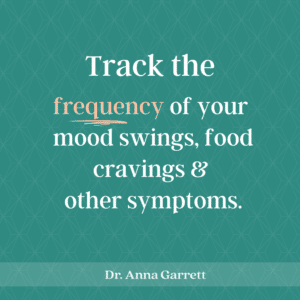Perimenopause can be sneaky.
Signs of perimenopause can start as early as your mid-late 30s. While you’re in the thick of raising kids (or considering having more), your ovaries may be making their retirement plan.
Maybe you’re having vague signs that something is changing such as insomnia, bloating, breast tenderness, anxiety, feeling tired all the time, or wonky periods (heavier, lighter, irregular, twice a month).
Maybe you’ve been to your doctor to discuss these things and you’ve been dismissed as “too young” to be in perimenopause. You’re offered birth control pills, antidepressants, or anti-anxiety meds and sent on your way.
But you know your body well and you have a feeling this is not what you need. Frustration sets in!
If you’re in your late 30s or early 40s and experiencing these things, you may be entering perimenopause. These symptoms are caused by an imbalance in estrogen and progesterone levels. Progesterone is the first hormone to fall as you move toward menopause. This happens because you don’t ovulate every month. Estrogen begins to run the show you’re your body all month and throws your hormone balance off. And if you’re stressed… cortisol joins the party and makes things even worse.
What Exactly IS Perimenopause?
Perimenopause is the stage in a woman’s life that leads up to menopause. It can last as long as 5-10 years on average. During this time, estrogen levels are rising and falling, progesterone is dropping like a rock, and testosterone may be increasing. Chin hairs anyone? All of this can add up to a host of unpleasant symptoms!
PMS or Perimenopause?
So how can you tell if your bad mood is a by-product of PMS or if it’s actually one of
 the symptoms of perimenopause? Track the frequency of your mood swings, food cravings, and other related symptoms. If they happen in the 2 weeks before your period and then go away, it’s probably PMS. But if you’re experiencing the symptoms all the time and they don’t go away when your period starts, it’s likely that you’ve entered perimenopause
the symptoms of perimenopause? Track the frequency of your mood swings, food cravings, and other related symptoms. If they happen in the 2 weeks before your period and then go away, it’s probably PMS. But if you’re experiencing the symptoms all the time and they don’t go away when your period starts, it’s likely that you’ve entered perimenopause
What’s the Next Step?
Once you’re pretty sure that your symptoms are related to perimenopause and a hormone imbalance and not PMS, it’s time to take action. Hoping it will all go away is not the best strategy! Perimenopause can last 5-10 years, and there’s no need to suffer for a big chunk of your life.
The first step is to get educated. That’s why I wrote my book, Perimenopause: The Savvy Sister’s Guide to Hormone Harmony. It’s a great place to begin your learning! Lifestyle changes and supplements can help 80% of women… no hormones needed! It’s helpful to work with someone who is knowledgeable about interpreting test results and the options for management. Many physicians are not familiar with testing, the use of BHRT, and the right supplements to help manage perimenopause. Your pharmacist, an herbalist, or a naturopath can be an excellent resource for this kind of information.
It’s also very helpful to know which hormones are out of balance so you can target the specific problem. Testing can be done with saliva, blood, or urine. Each method has its pluses and minuses. I use all three, depending on the client’s situation.
Your hormone levels may begin changing as early as 35 or as late as 50, but when they do, remember that perimenopause is an important, healthy, and natural stage of your life as a woman. It is not a disease or diagnosis that needs a cure. And you’re not going crazy. In short, there is nothing “wrong” with you or your body!
Dr. Anna Garrett is a menopause expert and Doctor of Pharmacy. She helps women who are struggling with symptoms of perimenopause and menopause find natural hormone balancing solutions so they can rock their mojo through midlife and beyond. Dr. Anna is the author of Perimenopause: The Savvy Sister’s Guide to Hormone Harmony. Order your copy at www.perimenopausebook.com.
Dr. Anna is available for 1-1 consultation. Find out more at www.drannagarrett.com/lets-talk




